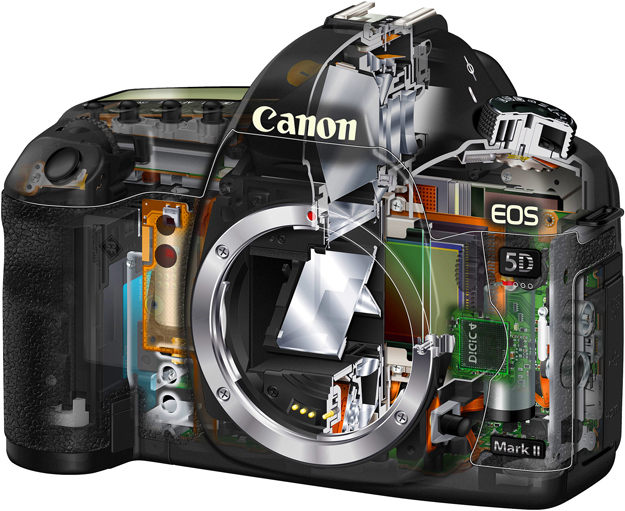From Erick: Today, we’re introducing a new feature at Photocrati, Q&A with Peter Burian. Peter has joined Photocrati as a contributor and will be writing detailed field reviews for digital SLR cameras as well as other gear-related articles. Once a week, he’ll also be choosing one question from our readers to answer. So if you have a gear question that’s been bothering or eluding you, send it to [email protected].
Question
What is your view of firmware updates for digital cameras? I often see that some manufacturer has posted yet another firmware update. Why do the companies release cameras before they are ready and then fix problems with new firmware? J.C.
Answer
As you indicate J.C., new firmware — the operating system for an electronic camera — is often issued. An update is simply a new binary file that will change the processing parameters or add certain functions. Modifications of this type could be made to a high-tech 35mm auto-focus SLR camera as well, but the installation process required a trained technician. While some firmware is designed to fix a technical problem, others actually enhance a camera with even better speed, accuracy, versatility or image quality. (It’s easy to find firmware updates with a Google search; use the keywords Support Firmware and the name of the manufacturer and the camera model.)
In any event, I decided to pose your question to one of the camera companies, and here’s their reply. “Designing and building any highly sophisticated computer controlled device always involves an ongoing process of fine tuning and testing of every possible combination of its features and capabilities. As demand for more features and better performance grows, we diligently test and re-test new designs in a constant quest to deliver the best product possible without glitches or bugs. But because firmware can be updated as necessary by the user, it’s a great way to correct quirks that occasionally come up or to add a new feature that becomes available after a camera is introduced.”
It’s worth checking for firmware updates once a month. (Save the pertinent Web page as a Favorite in your browser for easy access at any time.) Owners of Olympus, Panasonic and Sigma Four Thirds lenses and flash units (as well as owners of Metz flashes and the Nikon SB-900) may also find updates for those accessories. While installing any new firmware, be sure to follow the Instructions to the letter to avoid damaging the equipment. The updates from all manufacturers are available free of charge and they’re not difficult to install. That combination makes this an ideal method for keeping your equipment up to date and delivering the best possible performance.


PeterKBurian
27 Apr 2009P.S. Here’s a list of recent DSLR Firmware updates including hot links to the relevant pages:
April firmware update roundup http://www.dcresource.com/
* Canon EOS-50D: Fixes vertical banding when using sRAW1 setting; adds support for 270EX Speedlite; gives more specific error codes
* Canon EOS Rebel XS / XSi – adds support for 270EX Speedlite
* Nikon D40 / D40x – adds support for EN-EL9a battery
PeterKBurian
12 May 2009More Firmware updates:
Pentax K20D, See http://www.dpreview.com/news/0904/09041403pentaxk20dfirmware.asp
Olympus E3, See http://www.dpreview.com/news/0904/09040901olye3firmware.asp
Olympus E-30, See http://www.dpreview.com/news/0904/09040201olye30firmwareupdate.asp
ALL recent Canon EOS updates, see http://www.robgalbraith.com/bins/content_page.asp?cid=7-9991-10032
Nikon D700 and D3, See http://www.dpreview.com/news/0901/09012001canonnikonfirmwareupdate.asp
PeterKBurian
19 May 2009fyi:
Olympus has announced new Firmware for: Zuiko Digital 90-250mm, 8mm F3.5 Fisheye, 18-180mm F3.5-6.3 and ED 70-300mm F4.0-5.6 lens.
The firmware can be updated through Olympus Master software.
How to Update the Firmware:
http://www.olympus.co.jp/en/support/imsg/digicamera/qa/contents/03b/ssoftware10.cfm
PeterKBurian
27 May 2009May 27, 2009 UPDATE RE: EOS 5D Mk II Firmware: Canon announced today it will release a firmware update for the EOS 5D Mark II allowing users to manually control exposure when shooting video. The new firmware will be available for download from 2 June 2009 from the Canon Support Web page.
The update will include the following manual controls when shooting video:
* Full aperture selection
* ISO speed: Auto, 100 – 6400 and H1
* Shutter speed: 1/30th – 1/4000th second
For more info, see http://www.imaging-resource.com/NEWS/1243392276.html
PeterKBurian
2 Jun 2009More benefits with the new Firmware for the EOS 5D Mark II (version 1.1.0. )
This firmware update offers the manual video exposure control and these fixes/improvements:
• Disables the depth-of-field preview button when images are played back
• Fixes a problem with image peripheral illumination
• Fixes the algorithms of the Auto Lighting Optimizer
• Corrects indications in several language menus
• Changes battery info display for the Battery Grip
http://www.usa.canon.com/consumer/controller?act=ModelInfoAct&fcategoryid=139&modelid=17662#ModelDetailAct
PeterKBurian
1 Jul 2009Olympus updates Master and Studio software
July 2009 Olympus has released an update to its Master and Studio image-editing software. Version 2.2 of the Master and v2.3 of Studio enable users to apply Art Filter effects to RAW files, rather than having to choose them as you shoot. It also extends RAW support to the E-P1 and now includes a video editor to edit that camera’s HD videos.
Updates can be downloaded via Studio and Master’s ‘UPDATE SOFTWARE’ option.